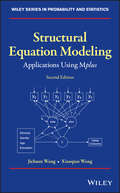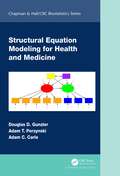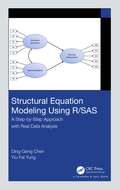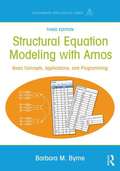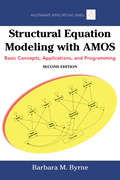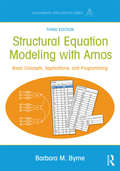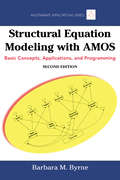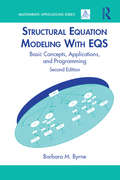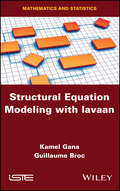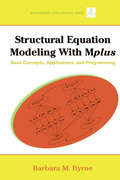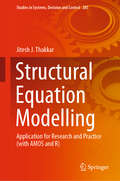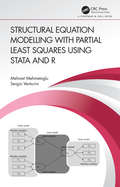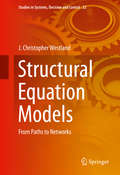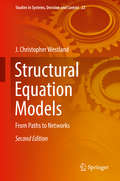- Table View
- List View
Structural Equation Modeling: Applications Using Mplus (Wiley Series in Probability and Statistics)
by Jichuan Wang Xiaoqian WangPresents a useful guide for applications of SEM whilst systematically demonstrating various SEM models using Mplus Focusing on the conceptual and practical aspects of Structural Equation Modeling (SEM), this book demonstrates basic concepts and examples of various SEM models, along with updates on many advanced methods, including confirmatory factor analysis (CFA) with categorical items, bifactor model, Bayesian CFA model, item response theory (IRT) model, graded response model (GRM), multiple imputation (MI) of missing values, plausible values of latent variables, moderated mediation model, Bayesian SEM, latent growth modeling (LGM) with individually varying times of observations, dynamic structural equation modeling (DSEM), residual dynamic structural equation modeling (RDSEM), testing measurement invariance of instrument with categorical variables, longitudinal latent class analysis (LLCA), latent transition analysis (LTA), growth mixture modeling (GMM) with covariates and distal outcome, manual implementation of the BCH method and the three-step method for mixture modeling, Monte Carlo simulation power analysis for various SEM models, and estimate sample size for latent class analysis (LCA) model. The statistical modeling program Mplus Version 8.2 is featured with all models updated. It provides researchers with a flexible tool that allows them to analyze data with an easy-to-use interface and graphical displays of data and analysis results. Intended as both a teaching resource and a reference guide, and written in non-mathematical terms, Structural Equation Modeling: Applications Using Mplus, 2nd edition provides step-by-step instructions of model specification, estimation, evaluation, and modification. Chapters cover: Confirmatory Factor Analysis (CFA); Structural Equation Models (SEM); SEM for Longitudinal Data; Multi-Group Models; Mixture Models; and Power Analysis and Sample Size Estimate for SEM. Presents a useful reference guide for applications of SEM while systematically demonstrating various advanced SEM models Discusses and demonstrates various SEM models using both cross-sectional and longitudinal data with both continuous and categorical outcomes Provides step-by-step instructions of model specification and estimation, as well as detailed interpretation of Mplus results using real data sets Introduces different methods for sample size estimate and statistical power analysis for SEM Structural Equation Modeling is an excellent book for researchers and graduate students of SEM who want to understand the theory and learn how to build their own SEM models using Mplus.
Structural Equation Modeling: Applications Using Mplus (Wiley Series in Probability and Statistics #9)
by Jichuan Wang Xiaoqian WangPresents a useful guide for applications of SEM whilst systematically demonstrating various SEM models using Mplus Focusing on the conceptual and practical aspects of Structural Equation Modeling (SEM), this book demonstrates basic concepts and examples of various SEM models, along with updates on many advanced methods, including confirmatory factor analysis (CFA) with categorical items, bifactor model, Bayesian CFA model, item response theory (IRT) model, graded response model (GRM), multiple imputation (MI) of missing values, plausible values of latent variables, moderated mediation model, Bayesian SEM, latent growth modeling (LGM) with individually varying times of observations, dynamic structural equation modeling (DSEM), residual dynamic structural equation modeling (RDSEM), testing measurement invariance of instrument with categorical variables, longitudinal latent class analysis (LLCA), latent transition analysis (LTA), growth mixture modeling (GMM) with covariates and distal outcome, manual implementation of the BCH method and the three-step method for mixture modeling, Monte Carlo simulation power analysis for various SEM models, and estimate sample size for latent class analysis (LCA) model. The statistical modeling program Mplus Version 8.2 is featured with all models updated. It provides researchers with a flexible tool that allows them to analyze data with an easy-to-use interface and graphical displays of data and analysis results. Intended as both a teaching resource and a reference guide, and written in non-mathematical terms, Structural Equation Modeling: Applications Using Mplus, 2nd edition provides step-by-step instructions of model specification, estimation, evaluation, and modification. Chapters cover: Confirmatory Factor Analysis (CFA); Structural Equation Models (SEM); SEM for Longitudinal Data; Multi-Group Models; Mixture Models; and Power Analysis and Sample Size Estimate for SEM. Presents a useful reference guide for applications of SEM while systematically demonstrating various advanced SEM models Discusses and demonstrates various SEM models using both cross-sectional and longitudinal data with both continuous and categorical outcomes Provides step-by-step instructions of model specification and estimation, as well as detailed interpretation of Mplus results using real data sets Introduces different methods for sample size estimate and statistical power analysis for SEM Structural Equation Modeling is an excellent book for researchers and graduate students of SEM who want to understand the theory and learn how to build their own SEM models using Mplus.
Structural Equation Modeling for Health and Medicine (Chapman & Hall/CRC Biostatistics Series)
by Douglas D. Gunzler Adam T. Perzynski Adam C. CarleStructural equation modeling (SEM) is a very general and flexible multivariate technique that allows relationships among variables to be examined. The roots of SEM are in the social sciences. In writing this textbook, the authors look to make SEM accessible to a wider audience of researchers across many disciplines, addressing issues unique to health and medicine. SEM is often used in practice to model and test hypothesized causal relationships among observed and latent (unobserved) variables, including in analysis across time and groups. It can be viewed as the merging of a conceptual model, path diagram, confirmatory factor analysis, and path analysis. In this textbook the authors also discuss techniques, such as mixture modeling, that expand the capacity of SEM using a combination of both continuous and categorical latent variables. Features: Basic, intermediate, and advanced SEM topics Detailed applications, particularly relevant for health and medical scientists Topics and examples that are pertinent to both new and experienced SEM researchers Substantive issues in health and medicine in the context of SEM Both methodological and applied examples Numerous figures and diagrams to illustrate the examples As SEM experts situated among clinicians and multidisciplinary researchers in medical settings, the authors provide a broad, current, on the ground understanding of the issues faced by clinical and health services researchers and decision scientists. This book gives health and medical researchers the tools to apply SEM approaches to study complex relationships between clinical measurements, individual and community-level characteristics, and patient-reported scales.
Structural Equation Modeling for Health and Medicine (Chapman & Hall/CRC Biostatistics Series)
by Douglas D. Gunzler Adam T. Perzynski Adam C. CarleStructural equation modeling (SEM) is a very general and flexible multivariate technique that allows relationships among variables to be examined. The roots of SEM are in the social sciences. In writing this textbook, the authors look to make SEM accessible to a wider audience of researchers across many disciplines, addressing issues unique to health and medicine. SEM is often used in practice to model and test hypothesized causal relationships among observed and latent (unobserved) variables, including in analysis across time and groups. It can be viewed as the merging of a conceptual model, path diagram, confirmatory factor analysis, and path analysis. In this textbook the authors also discuss techniques, such as mixture modeling, that expand the capacity of SEM using a combination of both continuous and categorical latent variables. Features: Basic, intermediate, and advanced SEM topics Detailed applications, particularly relevant for health and medical scientists Topics and examples that are pertinent to both new and experienced SEM researchers Substantive issues in health and medicine in the context of SEM Both methodological and applied examples Numerous figures and diagrams to illustrate the examples As SEM experts situated among clinicians and multidisciplinary researchers in medical settings, the authors provide a broad, current, on the ground understanding of the issues faced by clinical and health services researchers and decision scientists. This book gives health and medical researchers the tools to apply SEM approaches to study complex relationships between clinical measurements, individual and community-level characteristics, and patient-reported scales.
Structural Equation Modeling Using R/SAS: A Step-by-Step Approach with Real Data Analysis
by Ding-Geng Chen Yiu-Fai YungThere has been considerable attention to making the methodologies of structural equation modeling available to researchers, practitioners, and students along with commonly used software. Structural Equation Modelling Using R/SAS aims to bring it all together to provide a concise point-of-reference for the most commonly used structural equation modeling from the fundamental level to the advanced level. This book is intended to contribute to the rapid development in structural equation modeling and its applications to real-world data. Straightforward explanations of the statistical theory and models related to structural equation models are provided, using a compilation of a variety of publicly available data, to provide an illustration of data analytics in a step-by-step fashion using commonly used statistical software of R and SAS. This book is appropriate for anyone who is interested in learning and practicing structural equation modeling, especially in using R and SAS. It is useful for applied statisticians, data scientists and practitioners, applied statistical analysts and scientists in public health, and academic researchers and graduate students in statistics, whilst also being of use to R&D professionals/practitioners in industry and governmental agencies. Key Features: Extensive compilation of commonly used structural equation models and methods from fundamental to advanced levels Straightforward explanations of the theory related to the structural equation models Compilation of a variety of publicly available data Step-by-step illustrations of data analysis using commonly used statistical software R and SAS Data and computer programs are available for readers to replicate and implement the new methods to better understand the book contents and for future applications Handbook for applied statisticians and practitioners
Structural Equation Modeling Using R/SAS: A Step-by-Step Approach with Real Data Analysis
by Ding-Geng Chen Yiu-Fai YungThere has been considerable attention to making the methodologies of structural equation modeling available to researchers, practitioners, and students along with commonly used software. Structural Equation Modelling Using R/SAS aims to bring it all together to provide a concise point-of-reference for the most commonly used structural equation modeling from the fundamental level to the advanced level. This book is intended to contribute to the rapid development in structural equation modeling and its applications to real-world data. Straightforward explanations of the statistical theory and models related to structural equation models are provided, using a compilation of a variety of publicly available data, to provide an illustration of data analytics in a step-by-step fashion using commonly used statistical software of R and SAS. This book is appropriate for anyone who is interested in learning and practicing structural equation modeling, especially in using R and SAS. It is useful for applied statisticians, data scientists and practitioners, applied statistical analysts and scientists in public health, and academic researchers and graduate students in statistics, whilst also being of use to R&D professionals/practitioners in industry and governmental agencies. Key Features: Extensive compilation of commonly used structural equation models and methods from fundamental to advanced levels Straightforward explanations of the theory related to the structural equation models Compilation of a variety of publicly available data Step-by-step illustrations of data analysis using commonly used statistical software R and SAS Data and computer programs are available for readers to replicate and implement the new methods to better understand the book contents and for future applications Handbook for applied statisticians and practitioners
Structural Equation Modeling With Amos: Basic Concepts, Applications, And Programming, Third Edition
by Barbara M. ByrneThis bestselling text provides a practical guide to structural equation modeling (SEM) using the Amos Graphical approach. Using clear, everyday language, the text is ideal for those with little to no exposure to either SEM or Amos. The author reviews SEM applications based on actual data taken from her own research. Each chapter "walks" readers through the steps involved (specification, estimation, evaluation, and post hoc modification) in testing a variety of SEM models. Accompanying each application is: an explanation of the issues addressed and a schematic presentation of hypothesized model structure; Amos input and output with interpretations; use of the Amos toolbar icons and pull-down menus; and data upon which the model application was based, together with updated references pertinent to the SEM model tested. Thoroughly updated throughout, the new edition features: All new screen shots featuring Amos Version 23. Descriptions and illustrations of Amos' new Tables Viewformat which enables the specification of a structural model in spreadsheet form. Key concepts and/or techniques that introduce each chapter. Alternative approaches to model analyses when enabled by Amos thereby allowing users to determine the method best suited to their data. Provides analysis of the same model based on continuous andcategorical data (Ch. 5) thereby enabling readers to observe two ways of specifying and testing the same model as well as compare results. All applications based on the Amos graphical mode interface accompanied by more "how to" coverage of graphical techniques unique to Amos. More explanation of key procedures and analyses that address questions posed by readers All application data files are available at www. routledge. com/9781138797031. The two introductory chapters in Section 1 review the fundamental concepts of SEM methodology and a general overview of the Amos program. Section 2 provides single-group analyses applications including two first-order confirmatory factor analytic (CFA) models, one second-order CFA model, and one full latent variable model. Section 3 presents multiple-group analyses applications with two rooted in the analysis of covariance structures and one in the analysis of mean and covariance structures. Two models that are increasingly popular with SEM practitioners, construct validity and testing change over time using the latent growth curve, are presented in Section 4. The book concludes with a review of the use of bootstrapping to address non-normal data and a review of missing (or incomplete) data in Section 5. An ideal supplement for graduate level courses in psychology, education, business, and social and health sciences that cover the fundamentals of SEM with a focus on Amos, this practical text continues to be a favorite of both researchers and practitioners. A prerequisite of basic statistics through regression analysis is recommended but no exposure to either SEM or Amos is required.
Structural Equation Modeling With Amos: Basic Concepts, Applications, And Programming, Third Edition (PDF)
by Barbara M. ByrneThis bestselling text provides a practical guide to structural equation modeling (SEM) using the Amos Graphical approach. Using clear, everyday language, the text is ideal for those with little to no exposure to either SEM or Amos. The author reviews SEM applications based on actual data taken from her own research. Each chapter "walks" readers through the steps involved (specification, estimation, evaluation, and post hoc modification) in testing a variety of SEM models. Accompanying each application is: an explanation of the issues addressed and a schematic presentation of hypothesized model structure; Amos input and output with interpretations; use of the Amos toolbar icons and pull-down menus; and data upon which the model application was based, together with updated references pertinent to the SEM model tested. Thoroughly updated throughout, the new edition features: All new screen shots featuring Amos Version 23. Descriptions and illustrations of Amos' new Tables Viewformat which enables the specification of a structural model in spreadsheet form. Key concepts and/or techniques that introduce each chapter. Alternative approaches to model analyses when enabled by Amos thereby allowing users to determine the method best suited to their data. Provides analysis of the same model based on continuous andcategorical data (Ch. 5) thereby enabling readers to observe two ways of specifying and testing the same model as well as compare results. All applications based on the Amos graphical mode interface accompanied by more "how to" coverage of graphical techniques unique to Amos. More explanation of key procedures and analyses that address questions posed by readers All application data files are available at www. routledge. com/9781138797031. The two introductory chapters in Section 1 review the fundamental concepts of SEM methodology and a general overview of the Amos program. Section 2 provides single-group analyses applications including two first-order confirmatory factor analytic (CFA) models, one second-order CFA model, and one full latent variable model. Section 3 presents multiple-group analyses applications with two rooted in the analysis of covariance structures and one in the analysis of mean and covariance structures. Two models that are increasingly popular with SEM practitioners, construct validity and testing change over time using the latent growth curve, are presented in Section 4. The book concludes with a review of the use of bootstrapping to address non-normal data and a review of missing (or incomplete) data in Section 5. An ideal supplement for graduate level courses in psychology, education, business, and social and health sciences that cover the fundamentals of SEM with a focus on Amos, this practical text continues to be a favorite of both researchers and practitioners. A prerequisite of basic statistics through regression analysis is recommended but no exposure to either SEM or Amos is required.
Structural Equation Modeling With AMOS: Basic Concepts, Applications, and Programming, Second Edition
by Barbara M. ByrneThis bestselling text provides a practical guide to the basic concepts of structural equation modeling (SEM) and the AMOS program (Versions 17 & 18). The author reviews SEM applications based on actual data taken from her research. Noted for its non-mathematical language, this book is written for the novice SEM user. With each chapter, the author "walks" the reader through all steps involved in testing the SEM model including: an explanation of the issues addressed an illustration of the hypothesized and posthoc models tested AMOS input and output with accompanying interpretation and explanation The function of the AMOS toolbar icons and their related pull-down menus The data and published reference upon which the model was based. With over 50% new material, highlights of the new edition include: All new screen shots featuring Version 17 of the AMOS program All data files now available at www.routledge.com/9780805863734 Application of a multitrait-mulitimethod model, latent growth curve model, and second-order model based on categorical data All applications based on the most commonly used graphical interface The automated multi-group approach to testing for equivalence The book opens with an introduction to the fundamental concepts of SEM and the basics of the AMOS program. The next 3 sections present applications that focus on single-group, multiple-group, and multitrait-mutimethod and latent growth curve models. The book concludes with a discussion about non-normal and missing (incomplete) data and two applications capable of addressing these issues. Intended for researchers, practitioners, and students who use SEM and AMOS in their work, this book is an ideal resource for graduate level courses on SEM taught in departments of psychology, education, business, and other social and health sciences and/or as a supplement in courses on applied statistics, multivariate statistics, statistics II, intermediate or advanced statistics, and/or research design. Appropriate for those with limited or no previous exposure to SEM, a prerequisite of basic statistics through regression analysis is recommended.
Structural Equation Modeling With AMOS: Basic Concepts, Applications, and Programming, Second Edition
by Barbara M. ByrneThis bestselling text provides a practical guide to the basic concepts of structural equation modeling (SEM) and the AMOS program (Versions 17 & 18). The author reviews SEM applications based on actual data taken from her research. Noted for its non-mathematical language, this book is written for the novice SEM user. With each chapter, the author "walks" the reader through all steps involved in testing the SEM model including: an explanation of the issues addressed an illustration of the hypothesized and posthoc models tested AMOS input and output with accompanying interpretation and explanation The function of the AMOS toolbar icons and their related pull-down menus The data and published reference upon which the model was based. With over 50% new material, highlights of the new edition include: All new screen shots featuring Version 17 of the AMOS program All data files now available at www.routledge.com/9780805863734 Application of a multitrait-mulitimethod model, latent growth curve model, and second-order model based on categorical data All applications based on the most commonly used graphical interface The automated multi-group approach to testing for equivalence The book opens with an introduction to the fundamental concepts of SEM and the basics of the AMOS program. The next 3 sections present applications that focus on single-group, multiple-group, and multitrait-mutimethod and latent growth curve models. The book concludes with a discussion about non-normal and missing (incomplete) data and two applications capable of addressing these issues. Intended for researchers, practitioners, and students who use SEM and AMOS in their work, this book is an ideal resource for graduate level courses on SEM taught in departments of psychology, education, business, and other social and health sciences and/or as a supplement in courses on applied statistics, multivariate statistics, statistics II, intermediate or advanced statistics, and/or research design. Appropriate for those with limited or no previous exposure to SEM, a prerequisite of basic statistics through regression analysis is recommended.
Structural Equation Modeling With AMOS: Basic Concepts, Applications, and Programming, Third Edition (Multivariate Applications Series)
by Barbara M. ByrneThis bestselling text provides a practical guide to structural equation modeling (SEM) using the Amos Graphical approach. Using clear, everyday language, the text is ideal for those with little to no exposure to either SEM or Amos. The author reviews SEM applications based on actual data taken from her own research. Each chapter "walks" readers through the steps involved (specification, estimation, evaluation, and post hoc modification) in testing a variety of SEM models. Accompanying each application is: an explanation of the issues addressed and a schematic presentation of hypothesized model structure; Amos? input and output with interpretations; use of the Amos toolbar icons and pull-down menus; and data upon which the model application was based, together with updated references pertinent to the SEM model? tested. Thoroughly updated throughout, the new edition features: All new screen shots featuring Amos Version 23.?? Descriptions and illustrations of Amos’ new Tables View format which enables the specification of a structural model in spreadsheet form.???? Key concepts and/or techniques that introduce each chapter. Alternative approaches to model analyses when enabled by Amos thereby allowing users to determine the method best suited to their data.? Provides analysis of the same model based on continuous and categorical data (Ch. 5) thereby enabling readers to observe two ways of specifying and testing the same model as well as compare results. All applications based on the Amos graphical mode interface accompanied by more "how to" coverage of graphical techniques unique to Amos. More explanation of key procedures and analyses that address questions posed by readers All application data files are available at www.routledge.com/9781138797031. The two introductory chapters in Section 1 review the fundamental concepts of SEM methodology and a general overview of the Amos program. Section 2 provides single-group analyses applications including two first-order confirmatory factor analytic (CFA) models, one second-order CFA model, and one full latent variable model. Section 3 presents multiple-group analyses applications with two rooted in the analysis of covariance structures and one in the analysis of mean and covariance structures. Two models that are increasingly popular with SEM practitioners, construct validity and testing change over time using the latent growth curve, are presented in Section 4. The book concludes with a review of the use of bootstrapping to address non-normal data and a review of missing (or incomplete) data in Section 5. An ideal supplement for graduate level courses in psychology, education, business, and social and health sciences that cover the fundamentals of SEM with a focus on Amos, this practical text continues to be a favorite of both researchers and practitioners. A prerequisite of basic statistics through regression analysis is recommended but no exposure to either SEM or Amos is required.
Structural Equation Modeling with Amos: Basic Concepts, Applications, and Programming (Multivariate Applications Ser.)
by Barbara M. ByrneThis bestselling text provides a practical guide to the basic concepts of structural equation modeling (SEM) and the AMOS program (Versions 17 & 18). The author reviews SEM applications based on actual data taken from her research. Noted for its non-mathematical language, this book is written for the novice SEM user. With each chapter, the author "walks" the reader through all steps involved in testing the SEM model including: an explanation of the issues addressed an illustration of the hypothesized and posthoc models tested AMOS input and output with accompanying interpretation and explanation The function of the AMOS toolbar icons and their related pull-down menus The data and published reference upon which the model was based. With over 50% new material, highlights of the new edition include: All new screen shots featuring Version 17 of the AMOS program All data files now available at www.routledge.com/9780805863734 Application of a multitrait-mulitimethod model, latent growth curve model, and second-order model based on categorical data All applications based on the most commonly used graphical interface The automated multi-group approach to testing for equivalence The book opens with an introduction to the fundamental concepts of SEM and the basics of the AMOS program. The next 3 sections present applications that focus on single-group, multiple-group, and multitrait-mutimethod and latent growth curve models. The book concludes with a discussion about non-normal and missing (incomplete) data and two applications capable of addressing these issues. Intended for researchers, practitioners, and students who use SEM and AMOS in their work, this book is an ideal resource for graduate level courses on SEM taught in departments of psychology, education, business, and other social and health sciences and/or as a supplement in courses on applied statistics, multivariate statistics, statistics II, intermediate or advanced statistics, and/or research design. Appropriate for those with limited or no previous exposure to SEM, a prerequisite of basic statistics through regression analysis is recommended.
Structural Equation Modeling with Amos: Basic Concepts, Applications, and Programming (PDF) (Multivariate Applications Ser.)
by Barbara M. ByrneThis bestselling text provides a practical guide to the basic concepts of structural equation modeling (SEM) and the AMOS program (Versions 17 & 18). The author reviews SEM applications based on actual data taken from her research. Noted for its non-mathematical language, this book is written for the novice SEM user. With each chapter, the author "walks" the reader through all steps involved in testing the SEM model including: an explanation of the issues addressed an illustration of the hypothesized and posthoc models tested AMOS input and output with accompanying interpretation and explanation The function of the AMOS toolbar icons and their related pull-down menus The data and published reference upon which the model was based. With over 50% new material, highlights of the new edition include: All new screen shots featuring Version 17 of the AMOS program All data files now available at www.routledge.com/9780805863734 Application of a multitrait-mulitimethod model, latent growth curve model, and second-order model based on categorical data All applications based on the most commonly used graphical interface The automated multi-group approach to testing for equivalence The book opens with an introduction to the fundamental concepts of SEM and the basics of the AMOS program. The next 3 sections present applications that focus on single-group, multiple-group, and multitrait-mutimethod and latent growth curve models. The book concludes with a discussion about non-normal and missing (incomplete) data and two applications capable of addressing these issues. Intended for researchers, practitioners, and students who use SEM and AMOS in their work, this book is an ideal resource for graduate level courses on SEM taught in departments of psychology, education, business, and other social and health sciences and/or as a supplement in courses on applied statistics, multivariate statistics, statistics II, intermediate or advanced statistics, and/or research design. Appropriate for those with limited or no previous exposure to SEM, a prerequisite of basic statistics through regression analysis is recommended.
Structural Equation Modeling With AMOS: Basic Concepts, Applications, and Programming, Third Edition (Multivariate Applications Series)
by Barbara M. ByrneThis bestselling text provides a practical guide to structural equation modeling (SEM) using the Amos Graphical approach. Using clear, everyday language, the text is ideal for those with little to no exposure to either SEM or Amos. The author reviews SEM applications based on actual data taken from her own research. Each chapter "walks" readers through the steps involved (specification, estimation, evaluation, and post hoc modification) in testing a variety of SEM models. Accompanying each application is: an explanation of the issues addressed and a schematic presentation of hypothesized model structure; Amos? input and output with interpretations; use of the Amos toolbar icons and pull-down menus; and data upon which the model application was based, together with updated references pertinent to the SEM model? tested. Thoroughly updated throughout, the new edition features: All new screen shots featuring Amos Version 23.?? Descriptions and illustrations of Amos’ new Tables View format which enables the specification of a structural model in spreadsheet form.???? Key concepts and/or techniques that introduce each chapter. Alternative approaches to model analyses when enabled by Amos thereby allowing users to determine the method best suited to their data.? Provides analysis of the same model based on continuous and categorical data (Ch. 5) thereby enabling readers to observe two ways of specifying and testing the same model as well as compare results. All applications based on the Amos graphical mode interface accompanied by more "how to" coverage of graphical techniques unique to Amos. More explanation of key procedures and analyses that address questions posed by readers All application data files are available at www.routledge.com/9781138797031. The two introductory chapters in Section 1 review the fundamental concepts of SEM methodology and a general overview of the Amos program. Section 2 provides single-group analyses applications including two first-order confirmatory factor analytic (CFA) models, one second-order CFA model, and one full latent variable model. Section 3 presents multiple-group analyses applications with two rooted in the analysis of covariance structures and one in the analysis of mean and covariance structures. Two models that are increasingly popular with SEM practitioners, construct validity and testing change over time using the latent growth curve, are presented in Section 4. The book concludes with a review of the use of bootstrapping to address non-normal data and a review of missing (or incomplete) data in Section 5. An ideal supplement for graduate level courses in psychology, education, business, and social and health sciences that cover the fundamentals of SEM with a focus on Amos, this practical text continues to be a favorite of both researchers and practitioners. A prerequisite of basic statistics through regression analysis is recommended but no exposure to either SEM or Amos is required.
Structural Equation Modeling With EQS: Basic Concepts, Applications, and Programming, Second Edition (Multivariate Applications Series)
by Barbara M. ByrneReaders who want a less mathematical alternative to the EQS manual will find exactly what they're looking for in this practical text. Written specifically for those with little to no knowledge of structural equation modeling (SEM) or EQS, the author's goal is to provide a non-mathematical introduction to the basic concepts of SEM by applying these principles to EQS, Version 6.1. The book clearly demonstrates a wide variety of SEM/EQS applications that include confirmatory factor analytic and full latent variable models. Written in a "user-friendly" style, the author "walks" the reader through the varied steps involved in the process of testing SEM models: model specification and estimation, assessment of model fit, EQS output, and interpretation of findings. Each of the book's applications is accompanied by: a statement of the hypothesis being tested, a schematic representation of the model, explanations of the EQS input and output files, tips on how to use the pull-down menus, and the data file upon which the application is based. The book carefully works through applications starting with relatively simple single group analyses, through to more advanced applications, such as a multi-group, latent growth curve, and multilevel modeling. The new edition features: many new applications that include a latent growth curve model, a multilevel model, a second-order model based on categorical data, a missing data multigroup model based on the EM algorithm, and the testing for latent mean differences related to a higher-order model; a CD enclosed with the book that includes all application data; vignettes illustrating procedural and/or data management tasks; and description of how to build models both interactively using the BUILD-EQ interface and graphically using the EQS Diagrammer.
Structural Equation Modeling With EQS: Basic Concepts, Applications, and Programming, Second Edition (Multivariate Applications Series)
by Barbara M. ByrneReaders who want a less mathematical alternative to the EQS manual will find exactly what they're looking for in this practical text. Written specifically for those with little to no knowledge of structural equation modeling (SEM) or EQS, the author's goal is to provide a non-mathematical introduction to the basic concepts of SEM by applying these principles to EQS, Version 6.1. The book clearly demonstrates a wide variety of SEM/EQS applications that include confirmatory factor analytic and full latent variable models. Written in a "user-friendly" style, the author "walks" the reader through the varied steps involved in the process of testing SEM models: model specification and estimation, assessment of model fit, EQS output, and interpretation of findings. Each of the book's applications is accompanied by: a statement of the hypothesis being tested, a schematic representation of the model, explanations of the EQS input and output files, tips on how to use the pull-down menus, and the data file upon which the application is based. The book carefully works through applications starting with relatively simple single group analyses, through to more advanced applications, such as a multi-group, latent growth curve, and multilevel modeling. The new edition features: many new applications that include a latent growth curve model, a multilevel model, a second-order model based on categorical data, a missing data multigroup model based on the EM algorithm, and the testing for latent mean differences related to a higher-order model; a CD enclosed with the book that includes all application data; vignettes illustrating procedural and/or data management tasks; and description of how to build models both interactively using the BUILD-EQ interface and graphically using the EQS Diagrammer.
Structural Equation Modeling with lavaan
by Kamel Gana Guillaume BrocThis book presents an introduction to structural equation modeling (SEM) and facilitates the access of students and researchers in various scientific fields to this powerful statistical tool. It offers a didactic initiation to SEM as well as to the open-source software, lavaan, and the rich and comprehensive technical features it offers. Structural Equation Modeling with lavaan thus helps the reader to gain autonomy in the use of SEM to test path models and dyadic models, perform confirmatory factor analyses and estimate more complex models such as general structural models with latent variables and latent growth models. SEM is approached both from the point of view of its process (i.e. the different stages of its use) and from the point of view of its product (i.e. the results it generates and their reading).
Structural Equation Modeling with lavaan
by Kamel Gana Guillaume BrocThis book presents an introduction to structural equation modeling (SEM) and facilitates the access of students and researchers in various scientific fields to this powerful statistical tool. It offers a didactic initiation to SEM as well as to the open-source software, lavaan, and the rich and comprehensive technical features it offers. Structural Equation Modeling with lavaan thus helps the reader to gain autonomy in the use of SEM to test path models and dyadic models, perform confirmatory factor analyses and estimate more complex models such as general structural models with latent variables and latent growth models. SEM is approached both from the point of view of its process (i.e. the different stages of its use) and from the point of view of its product (i.e. the results it generates and their reading).
Structural Equation Modeling with Mplus: Basic Concepts, Applications, and Programming
by Barbara M. ByrneModeled after Barbara Byrne’s other best-selling structural equation modeling (SEM) books, this practical guide reviews the basic concepts and applications of SEM using Mplus Versions 5 & 6. The author reviews SEM applications based on actual data taken from her own research. Using non-mathematical language, it is written for the novice SEM user. With each application chapter, the author "walks" the reader through all steps involved in testing the SEM model including: an explanation of the issues addressed illustrated and annotated testing of the hypothesized and post hoc models explanation and interpretation of all Mplus input and output files important caveats pertinent to the SEM application under study a description of the data and reference upon which the model was based the corresponding data and syntax files available at http://www.psypress.com/sem-with-mplus/datasets . The first two chapters introduce the fundamental concepts of SEM and important basics of the Mplus program. The remaining chapters focus on SEM applications and include a variety of SEM models presented within the context of three sections: Single-group analyses, Multiple-group analyses, and other important topics, the latter of which includes the multitrait-multimethod, latent growth curve, and multilevel models. Intended for researchers, practitioners, and students who use SEM and Mplus, this book is an ideal resource for graduate level courses on SEM taught in psychology, education, business, and other social and health sciences and/or as a supplement for courses on applied statistics, multivariate statistics, intermediate or advanced statistics, and/or research design. Appropriate for those with limited exposure to SEM or Mplus, a prerequisite of basic statistics through regression analysis is recommended.
Structural Equation Modeling with Mplus: Basic Concepts, Applications, and Programming
by Barbara M. ByrneModeled after Barbara Byrne’s other best-selling structural equation modeling (SEM) books, this practical guide reviews the basic concepts and applications of SEM using Mplus Versions 5 & 6. The author reviews SEM applications based on actual data taken from her own research. Using non-mathematical language, it is written for the novice SEM user. With each application chapter, the author "walks" the reader through all steps involved in testing the SEM model including: an explanation of the issues addressed illustrated and annotated testing of the hypothesized and post hoc models explanation and interpretation of all Mplus input and output files important caveats pertinent to the SEM application under study a description of the data and reference upon which the model was based the corresponding data and syntax files available at http://www.psypress.com/sem-with-mplus/datasets . The first two chapters introduce the fundamental concepts of SEM and important basics of the Mplus program. The remaining chapters focus on SEM applications and include a variety of SEM models presented within the context of three sections: Single-group analyses, Multiple-group analyses, and other important topics, the latter of which includes the multitrait-multimethod, latent growth curve, and multilevel models. Intended for researchers, practitioners, and students who use SEM and Mplus, this book is an ideal resource for graduate level courses on SEM taught in psychology, education, business, and other social and health sciences and/or as a supplement for courses on applied statistics, multivariate statistics, intermediate or advanced statistics, and/or research design. Appropriate for those with limited exposure to SEM or Mplus, a prerequisite of basic statistics through regression analysis is recommended.
Structural Equation Modelling: Application for Research and Practice (with AMOS and R) (Studies in Systems, Decision and Control #285)
by Jitesh J. ThakkarStructural Equation Modeling provides a conceptual and mathematical understanding of structural equation modelling, helping readers across disciplines understand how to test or validate theoretical models, and build relationships between observed variables. In addition to a providing a background understanding of the concepts, it provides step-by-step illustrative applications with AMOS, SPSS and R software programmes. This volume will serve as a useful reference for academic and industry researchers in the fields of engineering, management, psychology, sociology, human resources, and humanities.
Structural Equation Modelling with Partial Least Squares Using Stata and R
by Mehmet Mehmetoglu Sergio VenturiniPartial least squares structural equation modelling (PLS-SEM) is becoming a popular statistical framework in many fields and disciplines of the social sciences. The main reason for this popularity is that PLS-SEM can be used to estimate models including latent variables, observed variables, or a combination of these. The popularity of PLS-SEM is predicted to increase even more as a result of the development of new and more robust estimation approaches, such as consistent PLS-SEM. The traditional and modern estimation methods for PLS-SEM are now readily facilitated by both open-source and commercial software packages. This book presents PLS-SEM as a useful practical statistical toolbox that can be used for estimating many different types of research models. In so doing, the authors provide the necessary technical prerequisites and theoretical treatment of various aspects of PLS-SEM prior to practical applications. What makes the book unique is the fact that it thoroughly explains and extensively uses comprehensive Stata (plssem) and R (cSEM and plspm) packages for carrying out PLS-SEM analysis. The book aims to help the reader understand the mechanics behind PLS-SEM as well as performing it for publication purposes. Features: Intuitive and technical explanations of PLS-SEM methods Complete explanations of Stata and R packages Lots of example applications of the methodology Detailed interpretation of software output Reporting of a PLS-SEM study Github repository for supplementary book material The book is primarily aimed at researchers and graduate students from statistics, social science, psychology, and other disciplines. Technical details have been moved from the main body of the text into appendices, but it would be useful if the reader has a solid background in linear regression analysis.
Structural Equation Modelling with Partial Least Squares Using Stata and R
by Mehmet Mehmetoglu Sergio VenturiniPartial least squares structural equation modelling (PLS-SEM) is becoming a popular statistical framework in many fields and disciplines of the social sciences. The main reason for this popularity is that PLS-SEM can be used to estimate models including latent variables, observed variables, or a combination of these. The popularity of PLS-SEM is predicted to increase even more as a result of the development of new and more robust estimation approaches, such as consistent PLS-SEM. The traditional and modern estimation methods for PLS-SEM are now readily facilitated by both open-source and commercial software packages. This book presents PLS-SEM as a useful practical statistical toolbox that can be used for estimating many different types of research models. In so doing, the authors provide the necessary technical prerequisites and theoretical treatment of various aspects of PLS-SEM prior to practical applications. What makes the book unique is the fact that it thoroughly explains and extensively uses comprehensive Stata (plssem) and R (cSEM and plspm) packages for carrying out PLS-SEM analysis. The book aims to help the reader understand the mechanics behind PLS-SEM as well as performing it for publication purposes. Features: Intuitive and technical explanations of PLS-SEM methods Complete explanations of Stata and R packages Lots of example applications of the methodology Detailed interpretation of software output Reporting of a PLS-SEM study Github repository for supplementary book material The book is primarily aimed at researchers and graduate students from statistics, social science, psychology, and other disciplines. Technical details have been moved from the main body of the text into appendices, but it would be useful if the reader has a solid background in linear regression analysis.
Structural Equation Models: From Paths to Networks (Studies in Systems, Decision and Control #22)
by J. Christopher WestlandThis compact reference surveys the full range of available structural equation modeling (SEM) methodologies. It reviews applications in a broad range of disciplines, particularly in the social sciences where many key concepts are not directly observable. This is the first book to present SEM’s development in its proper historical context–essential to understanding the application, strengths and weaknesses of each particular method. This book also surveys the emerging path and network approaches that complement and enhance SEM, and that will grow importance in the near future. SEM’s ability to accommodate unobservable theory constructs through latent variables is of significant importance to social scientists. Latent variable theory and application are comprehensively explained and methods are presented for extending their power, including guidelines for data preparation, sample size calculation and the special treatment of Likert scale data. Tables of software, methodologies and fit statistics provide a concise reference for any research program, helping assure that its conclusions are defensible and publishable.
Structural Equation Models: From Paths to Networks (Studies in Systems, Decision and Control #22)
by J. Christopher WestlandThis new edition surveys the full range of available structural equation modeling (SEM) methodologies. The book has been updated throughout to reflect the arrival of new software packages, which have made analysis much easier than in the past. Applications in a broad range of disciplines are discussed, particularly in the social sciences where many key concepts are not directly observable. This book presents SEM’s development in its proper historical context–essential to understanding the application, strengths and weaknesses of each particular method. This book also surveys the emerging path and network approaches that complement and enhance SEM, and that are growing in importance. SEM’s ability to accommodate unobservable theory constructs through latent variables is of significant importance to social scientists. Latent variable theory and application are comprehensively explained and methods are presented for extending their power, including guidelines for data preparation, sample size calculation and the special treatment of Likert scale data. Tables of software, methodologies and fit statistics provide a concise reference for any research program, helping assure that its conclusions are defensible and publishable.
